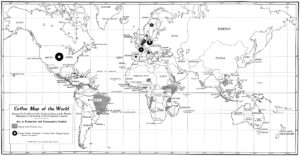
It is said that the Guianas are considered the first to plant coffee on the continent of South America, with the Dutch introducing it on their Dutch Guiana territories before the French and later British. According to some accounts, the Guianas were the first territories in the New World to cultivate and export coffee.
George Hanneman Bennett in his book, “An Illustrated History of British Guiana” wrote that coffee was cultivated on the colony since 1721 after it was introduced from what is now Surinam. Inland and coastland plantations were laid out by the Dutch, where it was often cultivated alongside sugar, indigo and cocoa.
By the time of Bennett’s 1866 book, explorers were regularly discovering long abandoned Dutch coffee plantations in such places like “Ooropocary, some 120 miles up the Essequibo River”.
Eventually, for a period, both coffee and sugar plantations would dot the colony’s coastland before sugar became the main export, and coffee estates were sold, abandoned or converted to sugar plantations.
William H. Ukers writes in “All about Coffee” (1922) that the plants were brought first into Dutch Guiana, but there was no planting in what was at the time British Guiana (then a Dutch colony) until 1752.
Twenty-six years later, 6,041,000 pounds were sent to Amsterdam from the two ports of Demerara and Berbice, and after the colony fell into the hands of the English in 1796, cultivation continued to increase. Exports amounted to 10,845,000 pounds in 1803; and to more than 22,000,000 pounds in 1810, he notes.
Then there was a decline, and the production in 1828 was 8,893,500 pounds and 3,308,000 pounds in 1836. In 1849 British Guiana exported only 109,600 pounds.
In 1842, the London Gazette recorded that the coffee plantations Java and Recht-door-Zee, Uitkourst, and Bourdeaux in Canal, No. 1 were up sale, while in 1844, Two Brothers and an estate called Mes Delices on the West Bank of Demerara were two other coffee plantations for sale.
Writing in 1922, Ukers notes that for a long period there was little production, and practically no exportation. Exports in 1907, for instance, amounted to only 160 pounds.
With the next year, however, a revival of exportation began, and continued to increase. In 1908, exports were 88,700 pounds, and by 1912 had increased to 144,845 pounds.
Despite a decline in 1913, exports reached 238,767 pounds in 1914; in 1916, 501,183 pounds and in 1917 reached 267,344 pounds. But coffee export never again reached the volume of the early-mid 19th century, and eventually ceased altogether.
Even at the time Bennett writes of the colony’s coffee plantations, he noted that there were few estates remaining, and coffee cultivation halted by “hostile tariffs”, while labour was too expensive to be profitable.



